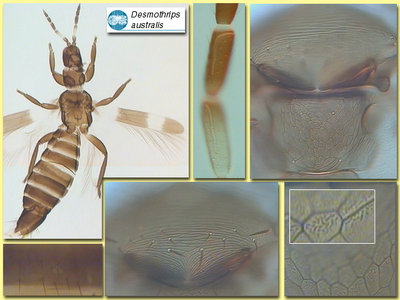Figures
Fig. 1 Head, thorax and abdomen
Fig. 2 Head (dorsal), III. and IV. antennal segment
Species
Desmothrips australis BagnallBiology
Adults and larvae feed in various flowers, but pupae occur on the ground. Probably both adults and larvae are facultative predators on the larvae of other flower living thrips species.
Distribution
Widespread in southern Australia.
Recognition
A large dark thrips with broad, banded forewings and antennal segment III slender and yellow with the extreme apex dark. Antennae 9-segmented, segments III & IV with linear sensorium in apical half; segments VI-IX forming a single unit. Maxillary palps with second segment subdivided into about 5 small units. Forewing with two dark transverse bands, apex of wing dark. Body with no long setae except at abdominal apex. Mesonotum with three or more pairs of setae medially. Metanotum reticulate, with small dot or wrinkle markings inside the reticles. Sternites III-VI with a transverse row of discal setae medially in addition to the posteromarginal setae. Male tergite IX without a pair of claspers.
Related species
Mound & Marullo (1998) provide keys to the 14 described species of Desmothrips, but state that further undescribed species are likely to exist. The genus is known only from Australia.



